
History
Like much of Cumbria, Gosforth retains a heritage of Norse culture. The most obvious relic of Norse presence in this area is the extraordinary Viking cross that stands in the churchyard of St Mary's parish church.
The Gosforth Cross is the tallest in England, and very probably the oldest. The surface of the cross is magnificently carved with likenesses of figures from Norse myth, including Loki, Heimdallr with his horn, Thor trying unsuccessfully to capture the Midgard Serpent, and Vioarr in battle with Fenrir.
What is fascinating about the cross is that it mixes these traditional Norse symbols with Christian symbols, including a Crucifixion scene. The cross is 4.4 metres tall and is thought to date to around AD 920.
There were once 2 crosses in Gosforth, but the second was cut down in 1789 to create a sundial base. A panel from the cross is on display inside the church, along with a pair of Viking hogback tombs.
Gosforth Hall
The Hall, now a hotel, was built in 1658 by Robert Copley. Look for the coat of arms over the door, dated 1673, which is when we can assume the Hall was completed. The coat of arms is pure fantasy, for it seems that Copley did not want to pay the fee demanded by the royal herald for an authentic coat of arms, so he made up his own. There is a secret hiding hole for priests behind the fireplace in the bar. The secret hole leads to Room 11, where guests have reported seeing the ghostly figure of a monk beside the priest hole.
Another historic building is the town hall and library, built in 1628. More recent is Steelfield Hall, built in 1840 for Sir Humphrey Senhouse and now serving as a home for the aged.
Outside the village is Blengdale Forest, a wooded area with walking trails along the River Bleng. If you fancy a cold pint after your exertions look out for the Lion and the Lamb public house or the Kellbank (formerly the Horse and Groom).
Five miles away is the medieval ruin of Egremont Castle, while the stately home of Muncaster Castle is about the same distance north.
 We've 'tagged' this attraction information to help you find related historic attractions and learn more about major time periods mentioned.
We've 'tagged' this attraction information to help you find related historic attractions and learn more about major time periods mentioned.


